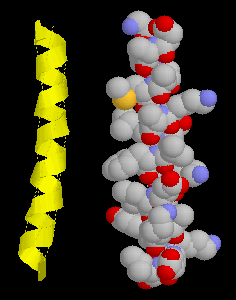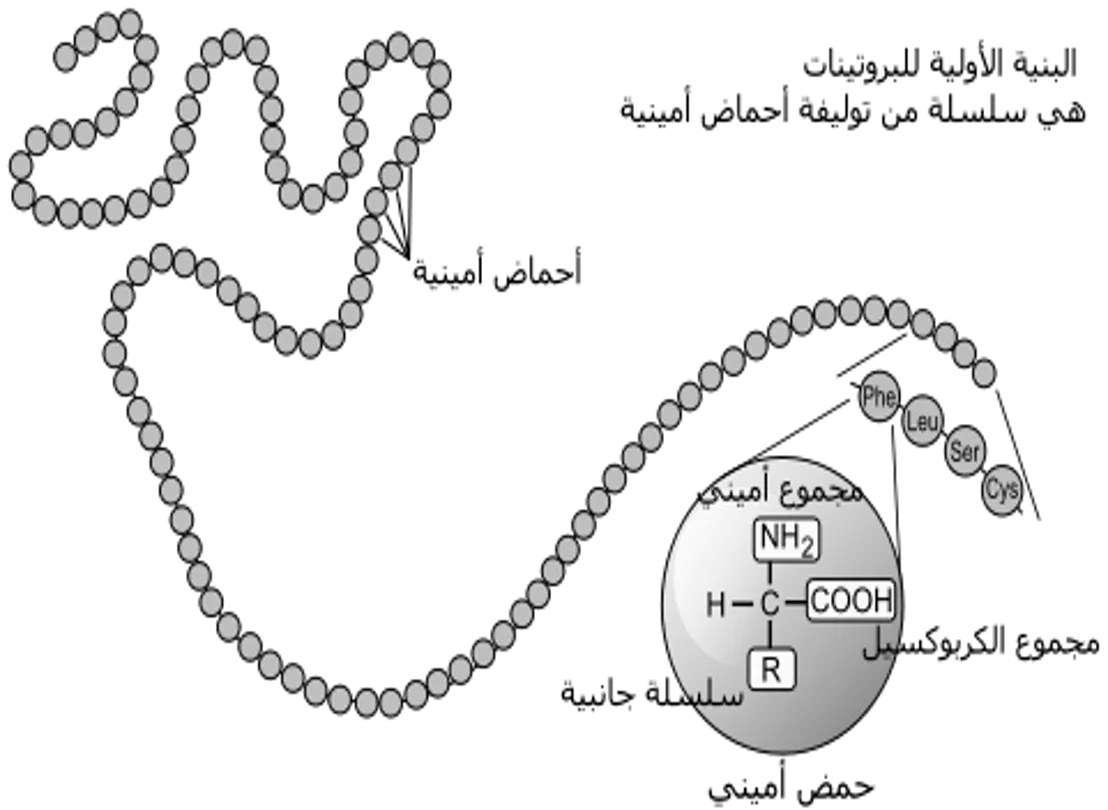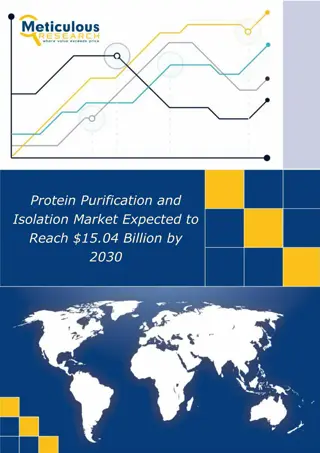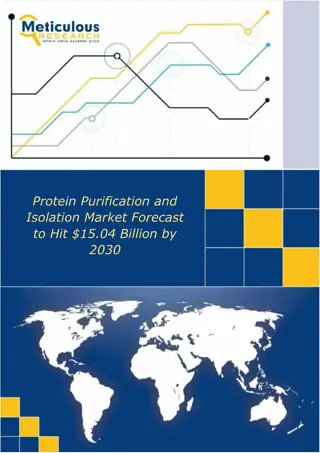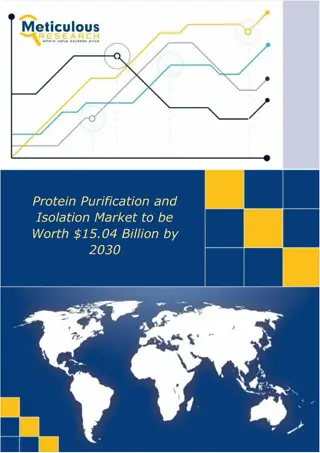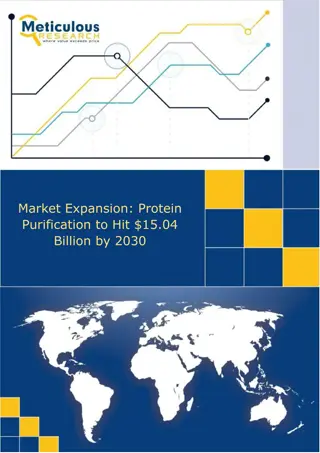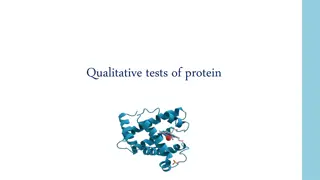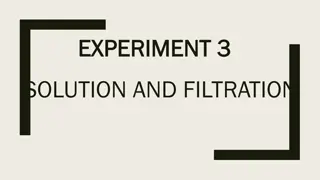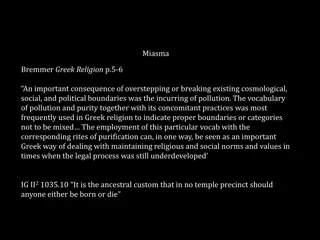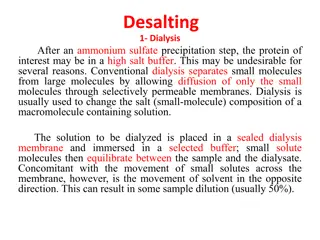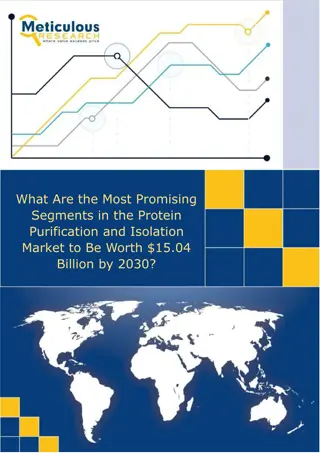Protein Isolation and Purification Techniques
This content discusses methods for protein isolation and purification, including selection of protein sources, solubilization techniques, stabilization methods, protein assays, and general strategies for protein purification using chromatography and electrophoresis.
Download Presentation

Please find below an Image/Link to download the presentation.
The content on the website is provided AS IS for your information and personal use only. It may not be sold, licensed, or shared on other websites without obtaining consent from the author. Download presentation by click this link. If you encounter any issues during the download, it is possible that the publisher has removed the file from their server.
E N D
Presentation Transcript
protein; isolation ;purification Chromatography Electrophoresis
: Proteinstructur-ar.svg
I. Protein Isolation A. Selection of a Protein Source-often can obtain the same or similar protein from several different sources chosea source with 1. .which can be obtained in large amounts and has .. 2.high concentration of the protein 3. .molecular cloning techniques allow production and purification of proteins from E. coli, yeast or other cells. B. Method of solubilization 1. .serum proteins or secreted proteins are already soluble 2. .otherwise cells must be broken up osmotic lysis; perhaps aided by enzymes or chemicals to weaken cell membranes (detergents solvents, or lysozyme for bacteria ( mechanical disruption by grinding, blending, homogenizingor ultrasonic disruption 3 .filter or centrifuge crude lysate to remove cell debris (membranes, cell walls etc ,)
C. Stabilization of proteins--proteins are delicate 1. .may be denatured by high temperature keep solution at appropriate temperature, usually fairly cold can use denaturation of some proteins to help purify a protein which is stable high temperature 2. Proteases are enzymes which break peptide bonds. maintain conditions which inhibit proteases ==> low temperature or changein or addition of chemical inhibitors. may use proteases to digest labile proteins if the protein of interest is stableto proteases. . at pH
D. Assay of Proteins-need some way of measuring the concentration of a specific protein, so we know when we're doing something right enzymes can be measured by the reactions they catalyze--either measure products produced or reactants used up . other proteins may be measured by their biological effects: ability to bind specific molecules or the effect of a hormone on cells, tissue or organism. . Immunochemical techniques-can produce antibodies which bind specifically to particular proteins
E. General Strategy of Protein Purification- fractionate based on different characteristic Proteins are purified by fractionation procedures in a series of steps. 1. Charge ion exchange chromatography Electrophoresis Isoelectric focusing 2. Polarity adsorption chromatography paper chromatography reverse-phase chromatography hydrophobic interaction chromatography
3. Size gel electrophoresis gel filtration chromatography ultracentrifugation dialysis and ultrafiltration II. Solubilities of Proteins A. Effects of Salt Concentration 1 . salting in : atlowconcentrationsofsalt, solubility of the proteins usually increase. 2 .salting out at high concentrations of salt,solubility of the protein decreasedsharply (precipitate),because the salt ions bind most of the water molecules Salt ions compete with protein globules for water and, eventually, at a sufficiently high concentration, strip the water of aqueous shell. Aqueous salt solution becomes a poor solvent for proteins, which precipitate out.
The number and distribution of charges, nonionic polar groups, and hydrophobic residues on the surface of the protein The size and shape of the protein . determines the concentration of the salt needed to cause precipitation of the protein. B. Effects of pH All proteins have an isoelectricpoint, pI, a pH at which they have no net charge, and they are least soluble at their pI because there are no net electrostatic repulsions between protein molecules:. Different proteins have different pI's, so one can manipulate the relative solubilities of a mixture of proteins by changing the pH. C. Crystallization Once a protein is reasonably pure, one may try to crystallize it which is the ultimate criterion of purity.
kinetic of protein precipitation involve the following. First, the protein environment is altered by the addition of a precipitating agent, causing the solution to become unstable disrupting bipolarity . Second, solid phase appears as small spherical primary particles of solid protein, which grow by diffusional transport of protein molecules to the solid surface. Third, primary particles aggregate as a result of convective transport and lead to floc formation. Finally, the aggregate (floc) size is limited by hydrodynamic disruption of the aggregates, generating smooth and uniform precipitate particles. maximizing the aggregate s size and density.
III. Chromatographic Separations One of the most power class of separation procedures is chromatography; this technique can take various forms based upon the physical apparatus column chromatography, paper chromatography, or thin layer chromatography . All depend upon having a mobile phase, usually a liquid, and a stationary phase, usually a solid coated with a liquid. The sample is applied in the mobile phase which passes down the column (or paper or thin layer plate) and the different solutes move at different speeds depending upon their relative affinities for the mobile and stationary phases; we say that they partition between the mobile and stationary phases.
The Chromatographic Matrix Achromatographic matrix should. (1) be insoluble in the buffer. (2) hydrophilic. (3) easily activated and coupled to a ligand (for affinity chromatography . (4) have large or small pores accessible to the protein (5) havea largesurfacearea. (6) be physicallyand chemicallystable towithstand the conditions during sterilization.
A variety of materials have been used as matrices. These include --inorganic materials glass, silica, and hydroxyapatite; -syntheticorganic polymers like polyacrylamide, polystyrene, and polysaccharides . agarose based (e.g., Sepharoseand Superose) - dextran based (e.g., Sephadex) - cellulose based (e.g., Sephacel). -
A. Ion Exchange Chromatography--adsorption chromatography 1. .Stationary Phase eseht ;dnuob snoi retnuoc htiw spuorg degrahc dnuob yllacimehc oina dnib hcihw spuorg degrahc ylevitisop eb yamn)anion exchanger ylevitagen ro ) ) snoitac dnib hcihw spuorg degrahccation exchanger) 2 .Mobile Phase htgnerts cinoi dna Hp :yb deziretcarahc noitulos reffub suoeuqa na 3 . Eluting Ion Exchange Columns ni reffub eht ni ylthgit brosda yllausu selucelom noitcaretni siht nekaew tsum >== deilppa er'yeht hcihw . Increase ionic strength (most common method): F = q1q2 / D r2 q1and q2are the charges on2 groups, r is the distance between the groups, and D is the dielectric constant of the solvent which is increased with higher ionic strength thus weakening the force between the solute and the ion exchanger. Another way to look at this is that other ions in the buffer compete for the ion exchanger binding site . change pH -- changes the charges on the molecules being separated; also can change the charge of a weak ion exchanger These changes can be made stepwise by changing the buffer reservoir (step gradient) or as gradient -- by mixing two buffers -- -- --
B. Gel Filtration Chromatography 1 .Column Packing ezis denifed fo sdaeb suorop lacirehps aicamrahP( xedahpeS ( crosslinked polyacrylamide ( crosslinked agarose sdaeb esoragA .)daR selucelom egral yrev gnitarapes rof doog ,erofereht ,era dna serop egral yrev evah other materials developed by other companies 2 .Gel beads are designed to have a distribution of pore sizes around a mean pore size. The mean pore size and the distribution determines the size range of molecules which can be separated . 3 .Dialysis is a form of molecular Filtration. -- crosslinked dextrans -- daR - oiB( P leG - oiB -- - oiB( A legoiB ro )aicamrahP( esorahpeS -- C. Affinity Chromatography based upon specific binding of the target protein to a particular ligand which is bound to an inert matrix .
D. Other Chromatographic Techniques 1 .Reverse Phase Chromatographystationary phase is more hydrophobic liquid adsorbed to inert matrix mobile phase is more hydrophilic liquid 2 .Hydrophobic Interaction Chromatography gnirutaned ssel >== spuorg cibohpordh dekcap ylesned ssel htiw tub . 3 .HPLC = High Performance Chromatography yb desaercni deeps ;noituloser esaercni ot esahp yranoitats eht ni selcitrap llams yrev htiw noi htiw osla tub edom esahp esrever ni desu ylnommoC .serusserp hgih yrev gnisu noitcaretni cibohpordyh ro ,noitartlif leg ,egnahcxe . yhpargotmorhc esahp esrever ot ralimis -- yhaprgotamorhc nmuloc fo mrof a --
File:Gas chromatograph.png Gas chromotography
spleen cells cytoplasm was applied on top of sepharose 6B gel filtration column. Flow rate was 30 ml /hrs, 5ml fraction collected. 0.045 0.04 0.035 Absorbance 280 nm 0.03 0.025 0.02 0.015 0.01 0.005 0 1 3 5 7 9 11 13 15 17 19 21 23 25 27 29 31 33 35 37 39 41 43 45 47 49 Fraction Numbre
Protein Electrophoresis is used to separate mixtures of protein (e.g., from cells, subcellular fractions, column fractions, or immunoprecipitates) inorder to investigate subunit compositions to verify homogeneity of protein samples to purify proteins for use in further application
ElectrophoresiS A. Macromolecule is accelerated by a force )like sedimentation) F = q E [q is the net charge on the molecule; E is the electric field strength experienced by the molecule] 2 .This causes an acceleration until the velocity, v, causes a frictional force equal to but opposite in direction to the applied force F = qE=fv 3 .Zonal: most common mode used sample is applied in a zone (small region: a spot on moistened paper or a band on a gel) and an applied field causes the molecules to separate into zones based upon different U's . Like Zonal sedimentation, need some way of stabilizing the zones to prevent mechanical mixing (from vibrations) or convection mixing (from temperature differences -- a particularly severe problem with resistance heating caused by the electric field.
Gel electrophoresis is a method used in clinical chemistry to separate proteins by charge and or size (IEF agarose, essentially size independent) and in biochemistryand molecular biology to separate a mixed population of DNA and RNA fragments by length, to estimate the size of DNA and RNA fragments or to separate proteins by charge. Nucleic acid molecules are separated by applying an electric field to move the negatively charged molecules through an agarose matrix. Shorter molecules move faster and migrate farther than longer ones because shorter molecules migrate more easily through the pores of the gel. This phenomenon is called sieving. Proteins are separated by charge in agarose because the pores of the gel are too large to sieve proteins. Gel electrophoresis can also be used for separation of nanoparticles
4- Gel electrophoresis media ; - Three types Starch Gel -- swollen potato starch granules (little used now except for prep isoelectric focusing) Agarose Gel -- purified large MW polysaccharide (from agar) ==> very open (large pore) gel used frequently for large DNA molecules Polyacrylamide Gels -- most commonly used gel because they are very stable and can be made at a wide variety of concentrations or even with a gradient of concentrations ==> large variety of pore sizes Acrylamide Concentrations -- typically 5-20% by weight (5%, 7.5%, 10%, 12.5%, 15%, 20% are commonly used values) ==> gel is mostly water. Acrylamidepolymerizes in head-to-tail fashion to form long polymers which form a complex network held together by bis-acrylamide crosslinks. The cris- crossing polymers create pores in the gel; the size of pores is determined by the acrylamideconcentraion. 5-. Acrylamidecan be polymerized into any desired shape -- two shapes used for electrophoresis Tube Gels -- polymerize in glass tubing ==> cylindrical shape Slab Gels -- polymerize between glass plates _--
B. SDS PolyAcrylamide Gel Electrophoresis -- SDS PAGE 1. Sodium Dodecyl Sulfate = Sodium Lauryl SulfateHC :3())(CH2)11SO-3Na+ This is a detergent because it contains a hydrophobic region, the CH3 ) CH2)11tail, attached to a hydrophilic group, SO3-Na+, making it amphipathic gnorts yrev a si tI . editpepylop eht ot gnidnib yb snietorp serutaned hcihw tnegreted backbone estimation of purity and molecular weight makes use of the detergent sodium dodecyl sulfate (SDS). Na+ - SO4(CH2)11CH3 SDS binds to most proteins in amounts proportional to the molecular weight of the protein, about one molecule of SDS for every twoamino acid residues. SDS, net negative charge, rendering the intrinsic charge of the protein insignificant and conferring on each protein a similar charge-to-mass ratio. Electrophoresis in the presence of SDS therefore separates proteins almost exclusively on the basis of mass (molecular weight).
Sodium dodecyl sulfate polyacrylamide gel electrophoresis (SDS-PAGE) is the most direct method for assessing in a fast and reproducible manner, the relative molecular weight (Mr) of denatured polypeptide chains and the purity of a protein preparation. In SDS-PAGE, the sample to be applied to the gel is first treated with the anionic detergent SDS which denatures the proteins in the sample and binds tightly to the protein molecules. The SDS molecules confer a relatively uniform negative charge to the polypeptide in proportion to its length. When an electric current is applied across the gel, all proteins will migrate through the gel matrix toward the anode. In this way, SDS-PAGE separates proteins according to size because the SDS- coated proteins have a uniform charge:mass ratio. Proteins with less mass travel more quickly through the gel than those with larger mass because of the sieving effect of the gel matrix
.C.IsoElectric Focusing:All protein charges vary from a net positive charge at low pH (-COOH and NH3 +forms of acidic and basic functional groups) through 0 at some intermediate pH to a net negative charge (-COO- and -NH3forms) at high pH. 1 .pI - IsoElectric Point ten a sah nietorp a hcihw ta Hp : 0 yraitret eht no elttil a dna noitisopmoc dica onima eht no yltsom sdnepeD .)ecnalab segrahc erutcurts 2 .Create a pH gradient in a gel: a no enod eb naC slab the final positions of each band depend only on an intrinsic property of the proteins, their Ip leg eht ni detrats yeht erehw no ton dna ,s' charge evitagen dna evitisop( a ro )latnoziroh ro lacitrev( tube. D .Two-Dimensional Electrophoresis:There are many variations; all basically combine 2 types of electrophoresis
Proteins Electrophoresis carried out in gels made up of the cross-linked polymer (polyacrylamide). The polyacrylamidegel acts as a molecular sieve, slowing the migration of proteins approximately in proportion to their charge-to-mass ratio. = V / E = Z / f , The electrophoreticmobility of the molecule. V, the velocity of the particle molecule, E, moving force of the molecule(electrical potential) Z, the net charge of the molecule. f, frictional coefficient.----- reflects in part a protein s shape. Different PAA Concentrations for different purposes
NonSDS-PAGE , Denatured SDS-PAGE, Nondenatured The proteins are visualized by adding a dye such as Coomassie blue, which binds to proteins but not to the gel itself. In compares' with the positions to which proteins of known molecular weight migrate in the gel, the position of an unidentified protein can provide a measure of its molecular weight. If the protein has two or more different subunits, the subunits will generally be separated by the SDS treatment and a separate band will appear for each





